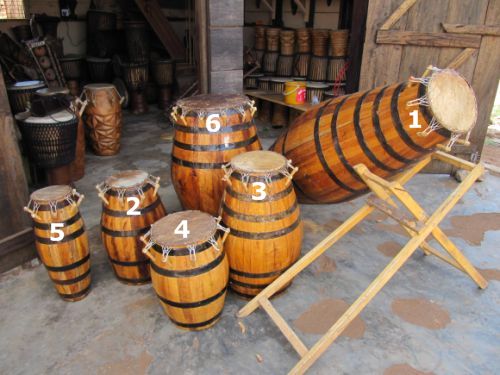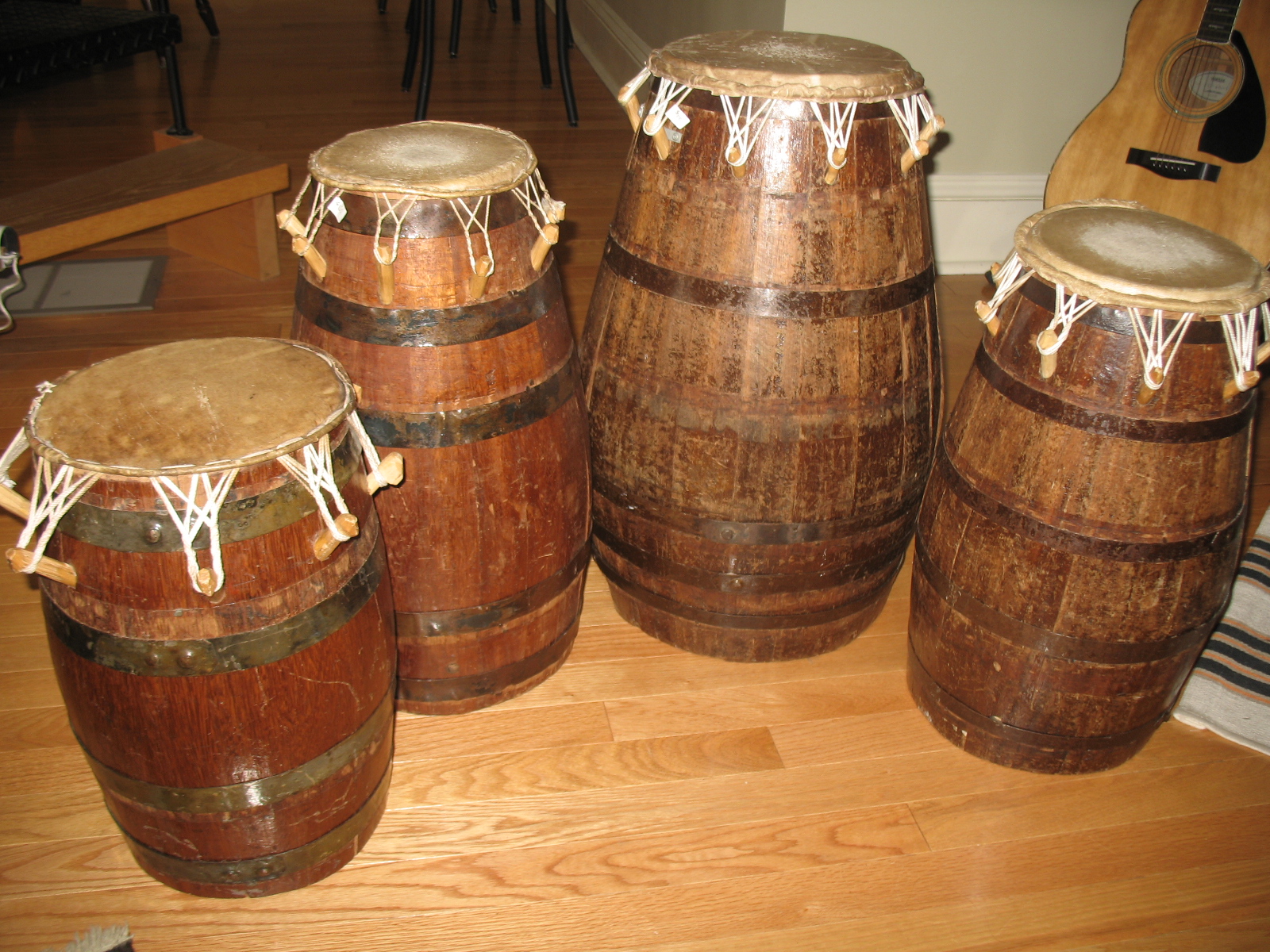

| EARTH METROPOLIS AFRICAN ART |
| ClaudeClark.com | Educ. | African | Search | African Studies | Art | Kuba | Kemet | Akan Art. | Adikra Cloth | Kente Cloth | Linguist | Stool Types | |
 |  |
|---|
|
Ghana has many types of drums and drum set ensemble. The name of the arranged set changes depending on what kind of drums are in each group or grouping. Each drum ensemble has a different use and a different purpose. The following are the names of drums in an Ewe ensemble set on the left: 1) Atsimevu 2) Kidi 3) Sogo 4) Kroboto/Tototzi 5) Kaganu 6) Agboba. The nextset of drums belong to the Ewe people as well. ORIGINS OF THE COOPERSMITH Traditionally in [England - Europe], a cooper is someone who makes wooden, staved vessels, bound together with hoops and possessing flat ends or heads. Examples of a cooper's work include but are not limited to casks, barrels, buckets, tubs, butter churns, hogsheads, firkins, tierces, rundlets, puncheons, pipes, tuns, butts, pins and breakers and [wheel barrel - wheelbarrow]. Traditionally, a hooper was the man who fitted the metal hoops around the barrels or buckets that the cooper had made, essentially an assistant to the cooper. The English name Hooper is derived from that profession. With time, many Coopers took on the role of the Hooper themselves. The word [coopersmith] is derived from Middle Dutch or Middle Low German kuper 'cooper' from kupe 'cask', in turn from Latin cupa 'tun, barrel'.[1] Everything a cooper produces is referred to collectively as cooperage. A cask is any piece of cooperage containing a bouge, bilge, or bulge in the middle of the container. A barrel is a type of cask, so the terms "barrel-maker" and "barrel-making" refer to just one aspect of a cooper's work. The facility in which casks are made is also referred to as a cooperage. Traditionally there were four divisions in the cooper's craft. The "dry" or "slack" cooper made containers that would be used to ship dry goods such as cereals, nails, tobacco, fruits and vegetables. The "dry-tight" cooper made casks designed to keep dry goods in and moisture out. Gunpowder and flour casks are examples of a "drytight" cooper's work. The "white cooper" made straight staved containers like washtubs, buckets and butter churns, that would hold water and other liquids, but did not allow shipping of the liquids. Usually there was no bending of wood involved in white cooperage. The "wet" or "tight" cooper made casks for long-term storage and transportation of liquids that could even be under pressure, as with beer. In the 21st century, coopers mostly operate barrel-making machinery and assemble casks [or kegs] for the wine and spirits industry. Plastics, aluminum and stainless steel drums; corrugated cardboard made dry and white coopersmith professions obsolete. During the 1960’s someone invented steel trailer truck container that could be lifted from trucks, placed on train flat cars or ships decks to be transported. Wooden barrels were too expensive for packaging goods.
COOPERSMITHS DURING COLONIALISM & THE SLAVE TRADE Much of the training of Africans for Western trade skills was probably done in Africa. An African blacksmith or an African woodcarver were probably of little use to Europeans as we have seen in the case of the venture capitalist and banker named Bartolomeo Marchionni - See more at: "African Studies" http://www.earthmetropolis.com/Earth/africa_studies.html#WHAT People displaying such trade skills of African origins would not fetch a high price or high trade in European or American slave markets. Those skills had to be modified or redirected. African craftsmen already had the technical skills before retraining, but their own culture was not marketable anywhere in the Western World. It would be the African blacksmith culture that stood in the way since it was so vastly different from Western blacksmith standards. The craftsmen to be sold or traded to the New World may have learned to speak some pidgin-English or Creole which would add to his higher sale or trade on the market as a slave. Cooperage requires very high skills but ranks low on the woodwright’s list. If an African was trained in such a field he could be traded as a carpenter or a blacksmith since a coopersmith is a hoopersmith as well. There are new drums on the market in Ghana as well as old ones. Who’s making the barrels? The following quote comes a pamphlet titled “Our Drums and Drummers, by J.H. Kwabena Nketia”: A third way of making drumsis to use strips of wood for building a drum shell. This method of making drums is used by the Ewe of South-Eastern Ghana. The strips, which look very much like the strips used for making barrels, are held together by iron hoops. When the right shell has been made, one end is covered with skin. The outside of the drum is then painted. The Anlo-Ewe like to paint their drums green or blue and red. “Our Drums and Drummers, by J.H. Kwabena Nketia” was published by Ghana Publishing House in 1968. Dr. Kwabena Nketia was director of Institute of African Studies at UNiversity of Ghana. There are new cooper drums on the market in Ghana as well as old cooper drums. Who’s making the barrels? Dr. Kwabena Nketia does not make it clear as to where the strips of wood come from. This form of drum making is so far different from all other drum types of drum industries in West Africa. Were coopersmith drums produced in Africa or were barrels manufactured in Europe and discarded in Africa; then if so why aren’t other Africans besides Ewe fashioning drums from barrels? I think Ewe people were taught cooperage during the early stages of the Atlantic slave trade, but I do not have any evidence to support that yet. I also believe that slaves were sold as carpenters and blacksmiths only after slave handlers had altered African iron and woodcarving crafts to Western standards. I don’t have proof of that either. Perhaps we shall get some answers soon.
Gahu Ensemble - According to Ewe Master Drummer Emmanuel Agbeli of Kopeyia, Ghana, Gahu is an adaptation of kokosawa, an older African drum and dance style that originated with the Yoruba people of neighboring Nigeria. The Ewe took kokosawa and increased the tempo to more than double its original value.
|
|---|